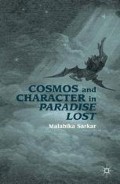Abstract
The incorporation of details of variable celestial phenomena in the portrayal of Satan in Paradise Lost reveals a complex process at work. It suggests that Milton consistently places Satan in the fallen world, aligning him with cosmic events—the appearance of new stars and comets—that cannot belong to the prelapsarian state. Such images defining Satan’s character that rely upon postlapsarian celestial details act as a means of collapsing the vital divide between the unfallen and the fallen worlds, projecting the Satanic presence as a perpetual threat. Satan thinks that he appropriates these variable cosmic phenomena, the new stars and comets, as modes of self-fashioning, disguises through which he wishes to demonstrate both his power and his astronomical acumen. But, for the reader, once these are contextualized, the cosmic details are seen to be in fact a powerful narrative device through which Satan’s true self is revealed. This becomes another instance of his evil intentions recoiling back on himself.
Access this chapter
Tax calculation will be finalised at checkout
Purchases are for personal use only
Preview
Unable to display preview. Download preview PDF.
Notes
Joad Raymond, Milton’s Angels, The Early-Modern Imagination (Oxford: Oxford University Press, 2010), p. 257.
Angelica Duran, The Age of Milton and the Scientific Revolution (Pittsburgh, Pennsylvania: Duquesne University Press, 2007), pp. 71–110, 179–207.
See John Rogers, The Matter of Revolution: Science, Poetry, & Politics in the Age of Milton (Ithaca and London: Cornell University Press, 1996). See also the discussion in chapter four.
Deborah E. Harkness, John Dee’s Conversations with Angel:, Cabala, Alchemy, and the End of Nature (Cambridge: Cambridge University Press, 1999), p. 72.
Alastair Fowler (ed.), Milton, Paradise Lost (Harlow: Longman, 2nd ed., 1998), pp. 472–73.
See also Harinder Singh Marjara, Contemplation of Created Things: Science in Paradise Lost (Toronto: University of Toronto Press, 1992), p. 267.
Gabor Ittzes, “Satan’s Journey through Darkness: Paradise Lost 9.53–86,” Milton Quarterly vol. 41, no. 1 (2007), 12–21.
See Lynn Thorndike, The Sphere of Sacrobosco and its Commentators (Chicago: University of Chicago Press, 1949), p. 126.
Sherry Lutz Zivley, “Satan in Orbit: Paradise Lost: IX: 48–86,” Milton Quarterly vol. 31, no. 4 (1997), 130–36.
Kent R. Lehnhof, “Uncertainty and ‘the Sociable Spirit’: Raphael’s Role in Paradise Lost,” in Milton’s Legacy, ed. Kristin A. Pruitt and Charles W. Durham (Selinsgrove: Susquehanna University Press, 2005), pp. 33–49.
Karen Edwards, “Inspiration and Melancholy in Samson Agonistes,” in Milton and the Ends of Time, ed. Juliet Cummins (Cambridge: Cambridge University Press, 2003), pp. 224–40.
Grant McColley, “Milton’s Dialogue on Astronomy: The Principal Immediate Sources,” PMLA, vol. LII, no. 3 (1937), 728–62.
John Wilkins, Discovery of a World in the Moone (1638);
Alexander Ross, The New Planet No Planet or the Earth no Wandering Star (London, 1646).
On the ideal pedagogical role played by Raphael, see also Margaret Olofson Thickstun, “Raphael and the Challenge of Evangelical Education,” Milton Quarterly vol. 35, no. 4 (2001), 245–57.
John Donne, “To the Countess of Bedford” (“To have written then …”) in A. J. Smith (ed.), John Donne: The Complete English Poems (Harmondsworth: Penguin Books Ltd., 1971), p. 228.
Eileen Reeves, Painting the Heavens, Art and Science in the Age of Galileo (Princeton: Princeton University Press, 1997), p. 8.
Robert Burton, The Anatomy of Melancholy (New York: De Capo Press, 1971), II, ii, 3.
Robert H. West, Milton and the Angels (Athens: University of Georgia Press, 1955), p. 180.
Anna K. Nardo, “The Education of Milton’s Good Angels,” in Arenas of Conflict, Milton and the Unfettered Mind, ed. Kristin Pruitt McColgan and Charles W. Durham (London: Associated University Presses, 1997), pp. 193–211.
Copyright information
© 2012 Malabika Sarkar
About this chapter
Cite this chapter
Sarkar, M. (2012). Milton’s Angels and Celestial Motion. In: Cosmos and Character in Paradise Lost. Palgrave Macmillan, New York. https://doi.org/10.1057/9781137007001_7
Download citation
DOI: https://doi.org/10.1057/9781137007001_7
Publisher Name: Palgrave Macmillan, New York
Print ISBN: 978-1-349-43519-7
Online ISBN: 978-1-137-00700-1
eBook Packages: Palgrave Literature CollectionLiterature, Cultural and Media Studies (R0)

